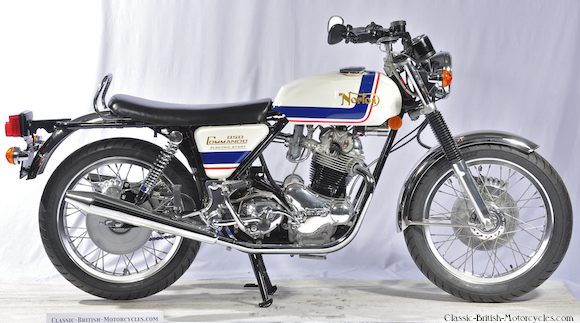1975 Norton Commando
ABOVE: 1975 Norton Commando MkIII Roadster in Union Jack paint scheme.
TROUBLE BEHIND THE SCENES
While the Norton Commando was enjoying reasonable success in the marketplace, other problems, both inside & outside the company wreaked havoc with Norton Motorcycles finances. By 1975, the Meriden Triumph fiasco was dying down finally, but the worker-takeover of the plant had curtailed Triumph twin production for 18 months, hurting the bottom line, since Norton now owned Triumph Motorcycles & BSA Motorcycles. What’s worse, the solution to the strike was for Norton-Villiers-Triumph (NVT) to cut Triumph loose, allowing its workers to form their own Meriden Co-operative. Of course BSA hadn’t built a bike since 1972. What must have seemed like a coup when Manganese Bronze Holdings (who owned Norton & AMC) scooped up Triumph & BSA, suddenly turned into one big money-losing dud. On top of all this, the British economy at the time was experiencing massive inflation & an energy crisis that drove Norton’s costs up to the point where profits were very slim at best.
NARROWER PRODUCT LINE
The result was a drastically cut-back product line. Gone were the John Player Norton & the hideous Hi-Rider. This allowed Norton to concentrate all of their dwindling resources on the 2 models that made up the core of their business: the 1975 Norton Commando Roadster & the 1975 Norton Commando Interstate, now both designated Mk III. The police-only 1975 Norton Commando Interpol was also produced & received the same upgrades as the other two models.

A CRIME AGAINST NATURE
After over 70 years of shifting on the right, Norton was forced to face a critical decision: Either switch the 1975 Norton Commando over to a left-foot-shift, or cease selling motorcycles in the U.S., by far it’s richest market. The Brits had practically invented foot shifting. The basic British layout (ie: timing side & gearbox on right, primary & clutch on left) had been ordained by God at the creation of the Universe. And it wasn’t arbitrary. Shifting with the left foot came in very handy in racing, which was mostly left-turns. So, this was a major change, both psychologically & mechanically. Triumph, the only other British motorcycle company still standing by 1975, was going through the same thing on both the Triumph Bonneville & the Triumph Trident T160.
NUMEROUS CHANGES
The changes needed to accomplish this were quite extensive. Of course, the shifter had to be moved from the right gearbox cover to the center of the primary cover. This was accomplished by solidly mounting the gearbox to the crankcase for the first time (using conventional tensioners to adjust the primary chain) & extending a shaft from the gearbox through the inner & outer primary chaincases.
This meant the brake pedal had to be moved to the right side & rather than re-engineer the rear drum brake setup, they upgraded it to a hydraulic rear disk brake (on the right). These changes required numerous modifications to the engine, frame & running gear. These included moving the front disk brake from the right side (as it had been on the rear drum brake bikes) to the left, for some obscure reason related to the handling.
In addition, a new vernier adjustment system replaced the shims as a means to adjust out the play in the Isolastic Suspension bushings. This system was part of the original design, but ruled out early on in the interest of cost-cutting. It was now re-introduced. What’s more, it could be retrofitted to any earlier Norton Commando.
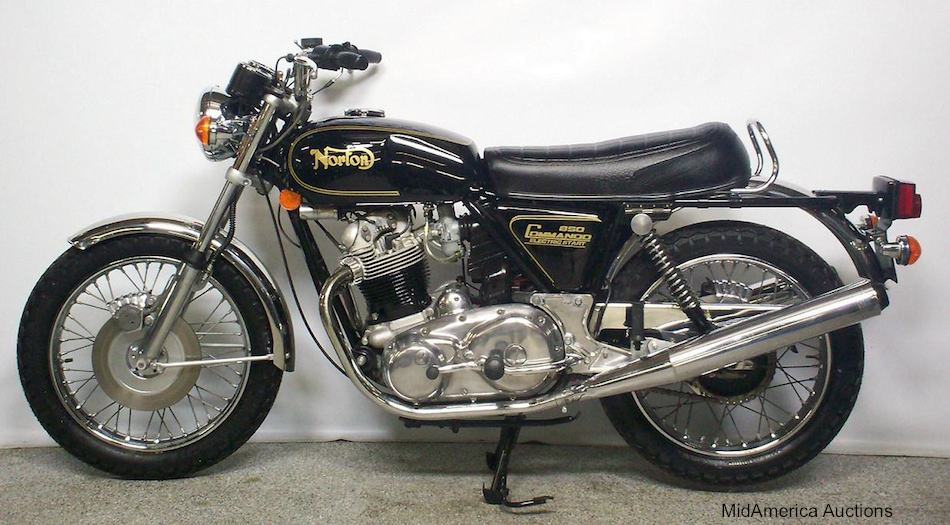
ELECTRIC STARTER, FINALLY!
A full decade after Honda started building big twins (Honda 450 DOHC) with electric starters, Norton Motorcycles finally introduced an electric starter for the 1975 Norton Commando. It was bolted to the inner primary case. Both inner & outer cases were new & were now fastened with several screws (like most bikes) rather than the time-honored single nut in the middle. It drove the left end of the crankshaft via a gear train & roller clutch.
NOT AS GOOD AS HOPED
The new starter was never a great success, working only intermittently, often too weak to turn the engine over fast enough to start it. Owners were glad that the kickstarter had been retained.
DETAIL CHANGES
The two basic models, the Roadster & Interstate, were mechanically identical & differed only in seat, side covers & fuel tank. By this time, Norton Motorcycles was streamlining & cutting costs wherever possible. They were now only painting the tanks & side covers, leaving the fenders polished. This also made color changes much easier to accomplish. The Interpol had its own unique tank, seat, valanced fenders (mudguards)& handlebars.
THE END IS NEAR
The Norton Commando had evolved just about as far as it could, given its 30-year-old engine design. As good as it was, it wasn’t nearly good enough to counter the incredible motorcycles being built by Honda, Yamaha, Suzuki & Kawasaki, on the racetrack or in the showroom. Antiquated manufacturing methods & a crippling British economy strapped Norton with high costs that never allowed it to clear a profit. How long could it go on like this?
1976, 1977 & 1978 NORTON COMMANDOS
As it turned out, about 2 more years. Limited production of the 1976 Norton Commando Roadster & the Commando Interstate continued in 1976 & was pretty much all carryover from 1975. A final production run of 1500 machines was built in 1977. By this time, Norton Motorcycles was in receivership. In 1978, a final batch of 30 Norton Commandos was built out of the parts that remained in the factory, now under the control of the courts. For all intents & purposes, 1977 was the last true model year for the Norton Commando & for Norton Motorcycles in general, at least insofar as OHV twin production goes…for the time being, anyway…
1975 Norton Commando INTERSTATE
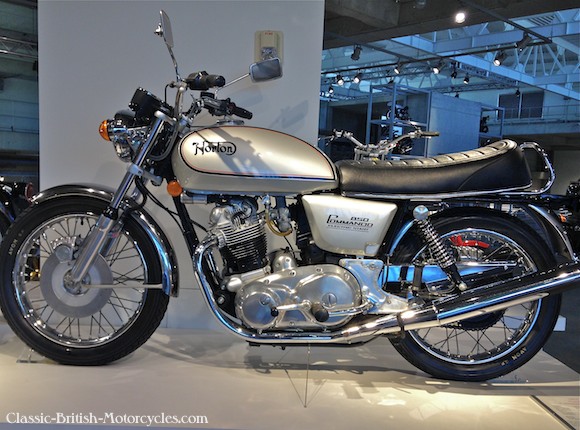
1975 NORTON COMMANDO INTERSTATE
The Interstate was yet another version of the evergreen Commando, again with no significant mechanical differences from any other 1975 Norton Commando. It was yet another appearance package with some functionality built in. The Interstate had a larger capacity fuel tank (5 US gallons over 3 gallons for non-Interstates), and a longer, wider, thicker seat, both to accommodate long-range touring. Since this was prior to factory touring bikes with factory fairings and saddlebags, owners would buy the Interstate then buy aftermarket pieces and hang them on the bike. Some looked better than others. Vetter always had nice stuff, but then again, it came down to the installation. Either way, the Commando was a fine touring bike, fast, smooth and torquey. And like all Nortons, gorgeous!
1975 Norton Commando FASTBACK

1975 NORTON COMMANDO FASTBACK
The Fastback was the first Norton Commando model when it debuted in 1968 as a 1969 model. Norton quickly expanded the Commando lineup that in it’s 7-model-year run included some seven distinctly different cosmetically, yet all mechanically identical, models. They stuck with the Fastback from start-to-finish in the Commando’s brief lifespan. What make the Fastback a Fastback was the cute little “ducktail” rear fender and seat combo. Otherwise, they were the same as the Roadsters, which had conventional rear fenders and seats.
1975 Norton Commando HI-RIDER

FACTORY CUSTOM
Norton (or more accuraely, ‘Norton-Villiers-Triumph’) was on life support when they came up with this lame attempt at a factory custom. To begin with, the only 2 other factory customs at the time, the ’71 Harley-Davidson FX Super Glide and the’73 Triumph Hurricane, never generated the anticipated sales. Ahead of their time, to be sure. So, the need for a factory custom, that would likely sell in meager numbers, was dubious at best. Despite this, Norton not only spent some of their scarce and dwindling resources on one, but they did a pretty horrible job of it. One can only assume that they took it for granted that they could peel off a nice slice of the American chopper boom, kicked off by the movie “Easy Rider”. They even tried to cash in on the name, calling this abomination the “Hi-Rider”. And high you rode on that horribly uncomfortable saddle, that pushed you downhill into the tank, whilst trying to reach those ridiculous “ape-hanger” handlebars. Few were sold, and most of those got converted back to normal bikes. Ironically, that makes an original, unmolested Hi-Rider quite rare, and their value has been rising over recent years.
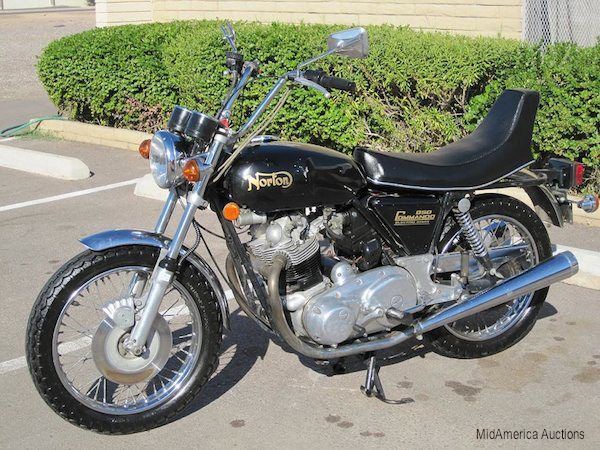
1975 John Player Norton (JPN)
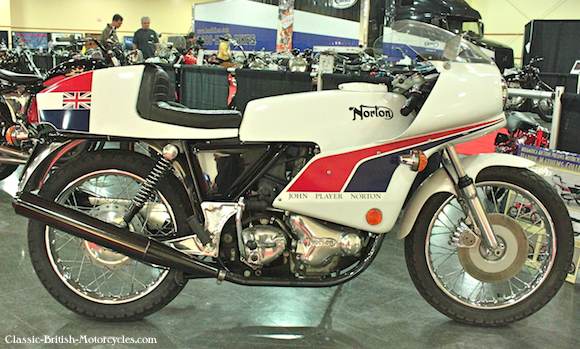
1975 JOHN PLAYER NORTON
In the early 1970s, Norton teamed up with British cigarette maker John Player to go racing in the Formula 750 Racing Series. They had some wins with riders Peter Williams, Dave Croxford and Mick Grant, and Norton decided to cash in on the attention they were getting. The John Player Norton or JPN was the result, and it is yet another example of Norton’s brilliant use of its standard hardware. For all it’s exotic looks, underneath, the JPN is just another Norton 850 Commando. It was all done with a body kit, special black exhaust and low bars. Nice work. All JPNs were built in the 1974 model year, but some unsold stock got registered as 1975s, like our subject bike.
1975 Norton Commando SPECIFICATIONS
|
Engine type Displacement Bore & Stroke Compression Carburetors Ignition Engine output Oil system Oil capacity Primary drive Clutch Gearbox Ratios, overall: 1st, bottom 2nd 3rd 4th, top Final drive Frame type Suspension, front Suspension, rear Brake, front Brake, rear Wheelbase Seat height Weight |
Air-cooled OHV parallel twin 828cc 77mm X 89mm / 3.03″ X 3.503″ 9.0:1 2- Amal Concentric, 32mm Battery & coil, Lucas 60 bhp @ 6200 rpm Dry sump 6 pts Triplex chain Multi-plate diaphragm, wet 4-speed constant-mesh, right-foot shift
12.40:1 8.25:1 5.90:1 4.84:1 Chain Welded double cradle, Isolastic Suspension Telescopic fork, hydraulic damping Swing Arm, 2 dampers, Isolastic mounts 10″ disk, 2-piston hydraulic caliper 7″ SLS drum, full width 57.1″ 31.3″ 419 lbs |


